Lucky Eddie
Sr. Member
- Feb 9, 2010
- 358
- 187
It amazed me that a search of this site found no mention of Australia's biggest "lost gold reef" legend of that of Lassetter!
Source:- http://www.gold-net.com.au/lasseter1.html
To this day many have searched and non have yet found Lasseters lost reef of gold.
Cheers
Source:- http://www.gold-net.com.au/lasseter1.html
Perhaps the greatest mystery in the charismatic saga of the Australian Gold fields, is the Legend of Lasseter's Reef.
Harold Lasseter was a man whose history and antecedents are shrouded in mystery. Even today debate rages as to the authenticity of his claim that he had found a fabulously rich gold reef, west of Alice Springs, Central Australia, somewhere near the Western Australian border.
To detail the whole saga in this brief resume is beyond the bounds of linguistic licence, however with further editions of Gold Net Australia Online specifics relating to this fabulous tale will be examined and commented on, in serialized form.
As you will read in further issues, the whole incredible saga raises more questions than it provides answers. Even today, the location of this fabulous wealth has not been found, and debate rages as to the validity or otherwise of this saga.
Lasseter was a prospector and miner who had both prospected and mined for gold and other treasure in Western Australia when gold was the backbone of the economies of this emerging nation.
He had been prospecting for rubies in the MacDonnell Ranges, west of Alice Springs, had become lost and had stumbled across a gold reef. He collected a bag of specimen gold and while trying to return to civilization became hopelessly lost. He was found by an Afghan camel driver, half starved, raving through thirst and delirious.
He was taken to a nearby surveyors camp, where he was nursed back to health. Some three years passed before Lasseter in company with a surveyor named Harding, who had been at the surveyor's camp at the time of his rescue, returned in search of the reef. As the story goes, they located the reef, took bearings and returned to civilisation at Carnavon on the north west coast of Western Australia.
Bearings had been taken using their watches, and they were dismayed to find that both their watches were substantially incorrect when they arrived at Carnavon. This of course meant that the bearings given would be incorrect and could be inaccurate by quite large distances.
Time passed. Lasseter was swept up in the rushes that were occurring all over Western Australia, and he worked both as a miner and a prospector throughout this time of plenty. Gold was literally oozing from the ground in almost inexhaustible quantities. Wealth was everywhere, and fortunes were being made.
The two men left at Ilbilba were quietly making their acquaintances with the local natives, many of whom had not seen a white man before. Caution was imperative, as spearing of white settlers was still a distinct possibility in this forbidding country. It was soon learnt that the native tribes of the area, were not only cautious of white men but also of other tribes, and stealing of lubra's (women) was common place, as were skirmishes between tribes for a variety of unrelated matters. Totally naked, well armed with spears, nulla-nulla's (clubbing sticks) and boomerangs, they were well equipped to both defend and attack as the situation arose. In general the tribes had a hierarchy, and well-regulated discipline. Each tribe with their own language, often unable to communicate with their 'next door neighbors'.
It was not unknown for native tribes to live in this manner in Australia right up to the 1960's.
With the arrival of the large truck back at Ilbilba, the expedition leaders re-assessed their position.
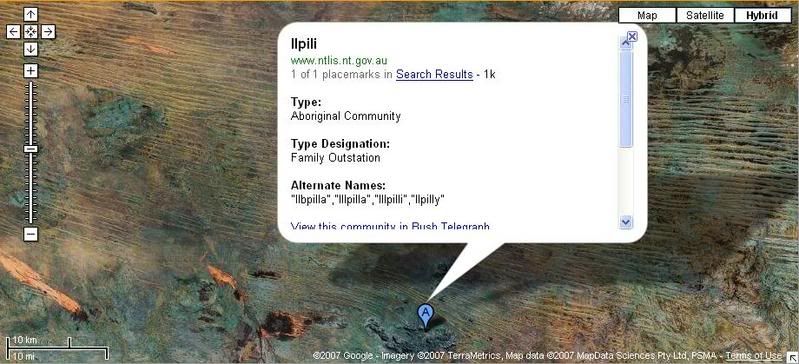
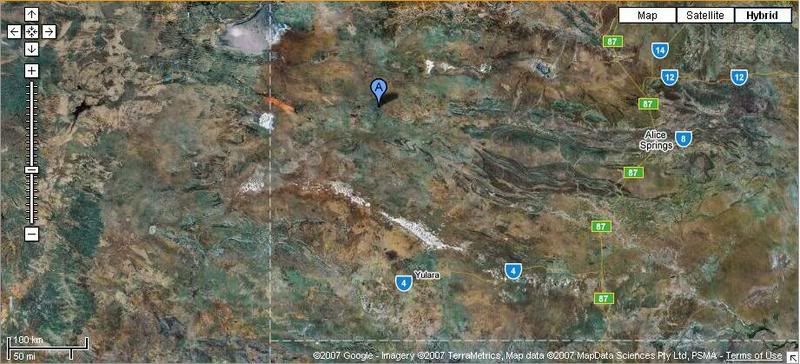
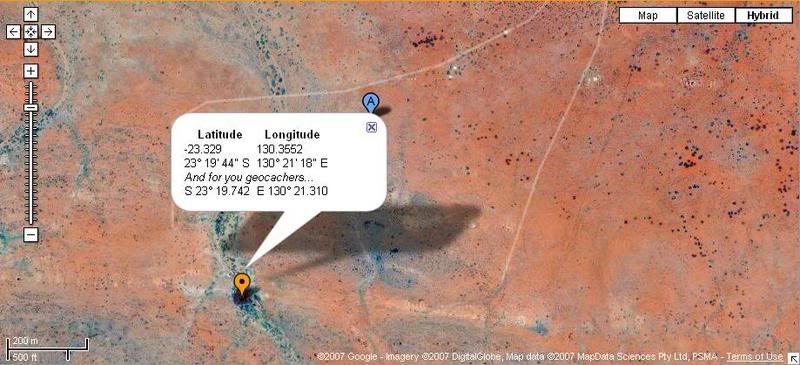
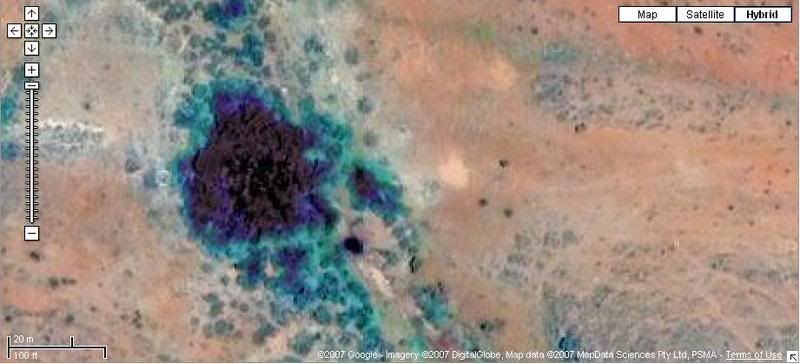
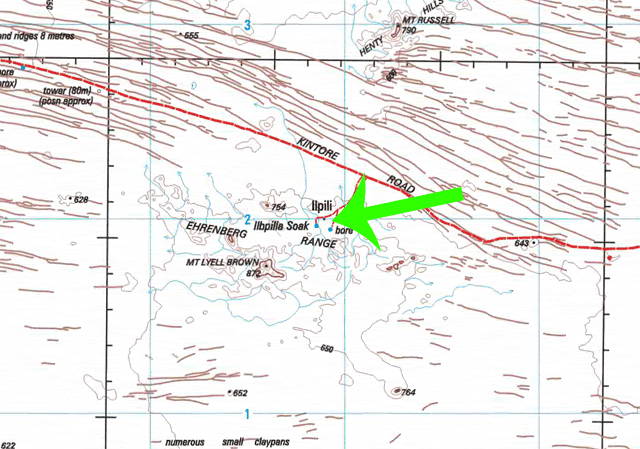
** This is Ilbilla/Illbilba soak today (Its an Aboriginal name there is no strictly correct spelling of it) viewed from google earth.**
The news was good, at last. The directors had supplied another aircraft, that was due to arrive at Ilbilba within days. The smaller truck returned to Alice Springs for more supplies while the larger returned to Ilbilba. After an agonizing wait the second truck arrived from Alice Springs with news that the aircraft was due to arrive the next day. The local inhabitants for many miles around were camped nearby enjoying the novelty of the white men in there midst. An air of tranquility existed, until the aircraft arrived. A 'bird' of this nature had never been seen before by the indigenous blacks, who promptly bolted in all directions, eventually crawling back to a safe distance where this huge 'creature' could be viewed with caution.
For over 20 years gold poured from the ground, but eventually, the bonanza slowed and the Western Australian government re-assessed the mineral resources of the State. In 1916 the Western Australian Government sent expeditions into the desert in an effort to find this lost treasure. They suffered attacks from the indigenous aborigines, and as casualties resulted, expeditions were abandoned.
Lasseter continued to seek support for a well-provisioned and equipped expedition into the desert to find his 'Eldorado', without success. Eventually Harold Lasseter convinced John Bailey, the influential President of the Australian Workers Union of the authenticity of his claim. Bailey investigated the claim and found records and other government data that substantially supported Lasseter's claim.
Through his influence, a company was formed and 5,000 pounds raised to finance and equip an expedition into the desert to re-locate the reef. Lasseter was overjoyed at his good luck. His time had come, after almost 30 years.
The expedition group consisted of two trucks and with the support of an aircraft that could provide a wider view of the vast territory to be covered. With great expectations the expedition set off into the desert on 21 July 1930. The intention was for the entire party, including the pilot to travel together, reach a suitable staging area where alanding strip would be made for the aircraft.
The pilot would then return to Alice Springs, collect the aircraft and fly to this location. After 9 days of relative easy going, they reached Taylor's Creek, some 240 miles west of Alice Springs. This area proved suitable for their purposes, and an air strip was constructed. The pilot in the smaller truck returned to Alice Springs in company with one other, who was to replenish the expedition with stores. The pilot flying on to Taylor's Creek where the aircraft would be secured, until a further landing site was found further west.
A few days later the aircraft aptly named the 'Golden Quest', arrived at the rough strip, along with the smaller truck with more supplies. All was going according to plan.
The re-grouped party secured the aircraft, and move on to the west towards Ilbilba. The country was forbidding and becoming more difficult to traverse daily. Progress was incredibly slow. Two miles an hour being the accepted rate. Ilbilba was reached.
A previous expedition had cleared a large staging area, quite suitable for use as a landing strip. The pilot and the second truck, set off back to Taylor's Creek to bring the aircraft forward, while the truck would return to Alice Springs and bring supplies forward. All went well until the aircraft lifted into the air. The motor stalled and the "Golden Quest", fell from the sky unceremoniously overturning on impact injuring the pilot. He was conveyed to Alice Springs in the truck in great pain. The party at Ilbilba waited expectantly for the aircraft. Realization that something was amiss was all too evident. Leaving two men at the camp to secure the stores the large truck headed back towards Taylor's Creek.
After 5 grueling days they arrived and located the damaged aircraft. Fortunately a note had been left, advising of the accident, and the necessity to convey the pilot, to Alice Springs for medical attention. A few days later, the party at Taylor's Creek was joined by the smaller truck en route to Ilbilba. The aircraft was dismantled, placed on this vehicle and returned to Alice Springs for transport to Adelaide for repairs.
It was decided to continue west, towards the area where hopefully Lasseter would recognize land marks and guide the party to the lost reef. The country was incredibly hard. Sand dunes blocked the way and the truck became bogged numerous times. On each occasion it had to be dug out by hand, move a few more yards, and had to be dug out again. The countries forbidding nature was taking it's toll, denying progress. After 10 days they had traveled a mere 100 miles, and they were now confronted by sand dunes that were clearly impassable. They had no alternative but to return to Ilbilba. Once there they were surprised to find that the second truck had not arrived back from Alice Springs as expected, and a decision was made for the large truck to return to Taylor's Creek to search for them. They continued past Taylor's Creek, and eventually located the second truck many miles further east.
The next day with Lasseter on board, the aircraft headed west, seeking recognizable landmarks. They were found, but the limited range of the flying observation platform was considered a huge draw back, so it was decided to fly the aircraft to Adelaide via Alice Springs for a new engine and larger fuel tanks to be fitted. The ground party headed southwest towards the country Lasseter had recognized. The going became increasingly difficult and eventually became impassable to the vehicles. There was no alternative but to return to Ilbilba, and seek instructions from the directors. Lasseter was hell bent on continuing at all costs, and when they arrived back at the staging camp, they were surprised to find a man called Johns was there with 5 camels. After some negotiating, Johns was engaged and with Lasseter they headed back into the desert.
Upon hearing the news the directors decided to provide what support they could. A ground party was despatched, which consisted of camels, and a plane was organized for aerial support. Before the aircraft could be utilized it was damaged on the ground at Alice Springs, and repairs had to be undertaken. The ground party was to go to Ayers Rock to pr However, when the aircraft arrived no ground party could be seen. It had struck trouble with the camels that had bolted one night into the desert, and the 'rescue' party had returned to Alice Springs.
As the aircraft landed, a slither of wood from the propeller flew off, narrowly missing the pilot's head. The prop was too badly damaged for the craft to take to the air. By this time Lasseter and Johns were in familiar territory. The country was difficult but with camels negotiable. They were close to their goal. About 20 miles from the reef, Lasseter left Johns with the camels and went on alone. He could not contain his elation, when he set eyes on his dream again. He stood silently, drinking in the golden hue before him.
He rejoined Johns, confirming what he had found. Johns became suspicious and after some tense days a fight broke out where a pistol was used with near disastrous consequences. A shaky truce existed as they returned to Ilbilba to bring the news to the world. Lasseter was delighted.
At Ilbilba, Johns was dispatched back to Alice Springs, with the news. Lasseter, replenished his supplies and with two camels headed back to the site. His intention was to peg the claim, take bearings and recover samples. A lone white man in this forbidding country would be easy prey, should an unfriendly tribe be encountered. Plumes of smoke occasionally appeared indicating his progress was being watched. At times black figures appeared, brandishing spears, indicating his presence was unwelcome. On other occasions, the blacks displayed a friendly pose and communications were pleasant. The camels were becoming increasingly difficult to control. He pegged the claim and started back towards Ilbilba.
Tragedy struck late in the afternoon, when both camels bolted, leaving him alone in the desert without water and with little food. He recognized the fragility of his position, and knew he would have to seek assistance from the indigenous inhabitants if he was to survive.
At Ayers rock, the pilot had been stranded for almost a week without water or food. Thirst was draining his common sense and reason. Fortunately the party sent to establish a base camp at the rock eventually arrived, rescued the pilot, repaired the propeller and the aircraft returned to Alice Springs for expert repairs. When the repairs were complete the aircraft lifted into the air again, with a pilot and co-pilot heading for Ilbilba. On this occasion with neither man familiar with the country and with inaccurate charts, they became hopelessly lost, eventually landing in formidable country. Only one thing to do with little food and no water. Walk back to Alice Springs. They began in great heart, but eventually were driven to remain near a drying water hole for the little sustenance it provided.
Search parties were organized. One left Hereinafter Mission, and another left Alice Springs, while the RAAF (Royal Australian Air Force) were asked to assist. A number of aircraft arrived at Alice Springs and a systematic air search commenced. At times the two starving men could see aircraft in the distance, and knew that help was near. They had been stranded for almost three weeks, when they heard the drone of the engine approaching overhead. They jumped for joy when the aircraft slowly circled and dropped food and water. Later that day a ground party arrived and rescued them from their torment. They were taken to Tempe Downs Station. Lasseter was still in the desert. By this time he had joined up with a tribe of indigenous natives. Knowing that rescue parties would be heading for him, he promised great quantities of food.
The tribal chief, Watta Mitta Mitta, was skeptical, and had encouraged his young warriors to kill him, then and there. Lasseter was a cunning man and made friends with the older lubra's (women), and an old man he called Old Warts, as he had an over abundance of them on his back. Old Warts protected Lasseter on many occasions during the harrowing weeks he was to endure, with little food or water, for both himself and his reluctant hosts. The desert was unrelenting, and unforgiving, and after many weeks of enduring unspeakable hardship, Lasseter s strength was waning. He was desperate.
At Tempe Downs Station the company commissioned the owner Bob Buck to find Lasseter. Buck was a fine bushman, with extensive experience. In one of the great feats of endurance Buck traversed the country for 11 weeks seeking tracks that would lead to Lasseter.
At last he found signs, and following them relentlessly, eventually came across a large gathering of blacks. At first they denied any knowledge of Lasseter, but eventually he was taken to the place where Lasseter had breathed his last breath.
The aborigines had not killed him, but their lack of support indeed aided his eventual demise. Buck buried him where he lay, and searched for notes and other messages. The actual location of the reef, although recorded by Lasseter, was lost, as were the samples he had buried.
To this day, the location of this fabulous wealth remains lost in the forbidding desert of Central Australia. There are those who dismiss this whole saga, as being one of the great confidence tricks of this century. Others prefer to believe the truth of the legend. In recent years, several expeditions have been mounted to this vast area without success. Innumerable questions remain unanswered. Perhaps in time, the secret of Lasseter's Reef will be discovered. In the meantime, the Legend of Lasseter continues.
To this day many have searched and non have yet found Lasseters lost reef of gold.
Cheers




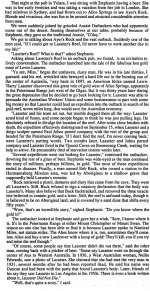
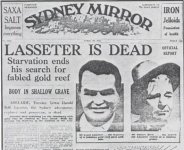




 Kidding aside, in my book that partner is every bit as important as the one doing the digging.
Kidding aside, in my book that partner is every bit as important as the one doing the digging. 

